Business Maverick, Media
From our vault: The Karoo Chronicles II – The naming of parts
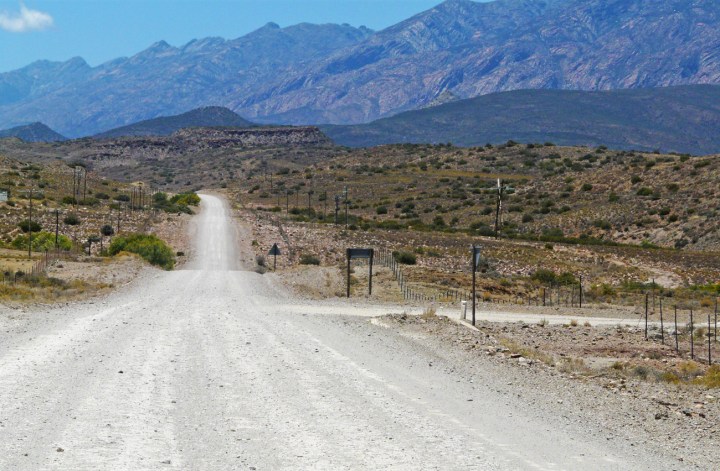
One of the oddities of great open spaces is how few names there are. The two things are somehow indelibly paired; openness almost necessarily implies namelessness. The opposite applies too: discovery is synonymous with that fabulous process of anointing things with a designation. By TIM COHEN.
This process is made all the more delicious because you have a sense that not only are things being named, but they are being named for the first time. In fact, they are not being named, they are being christened. It’s almost as though the mere process of naming brings the things under human jurisdiction whereas before they were bereft and lost in the meaninglessness of vast, open space.
Of course, they were never lost, and they cannot become “found” merely by being announced. Yet something named does pass through an imaginary wall moving it from the realm of the unknown to the realm of the familiar, even if it is not known or not familiar.
It’s easy to imagine how the conversation would go. Question: Have you ever been to that nondescript place way over there behind that nondescript koppie? Answer: No, never been there. Alternatively … Question: Have you ever been to Grootgattussendierotse? Answer: No, but I hear it’s fabulous.
Faced with this splendid responsibility of inculcating natural features with names which, one hopes, will stretch on into eternity, the most common response is simply to be awestruck and pick names that are almost absurdly underwhelming.
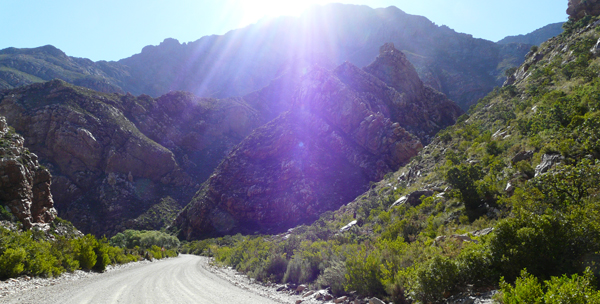
Photo: Seweweekspoort is one of the links between The Great and Little Karoo. (Max Kaizen)
The Karoo itself is a perfect example. The Karoo is divided into the Klein Karoo (Little Karoo) and the … let’s see now … what should we call it? Wait, wait, I know! The Groot Karoo. This is normally translated as the Great Karoo to ascribe it some grandiose dignity, given its size.
So we have a big bit and a small bit. Fabulous. Nobody could have thought of that.
As it happens, the big bit is actually really, really big. It’s about 400,000 square kilometres, about the same size as Germany or Montana. To call something that size, something which includes farms that stretch beyond eyesight “big” or “great” is a misnomer of, well, really vast proportions. Things that are big you can summit with the kind of ladder you buy at Dions. The big Karoo is not scalable with stuff you buy anywhere in the known universe.
The Little Karoo is, if anything, even more of a misnomer. Who on earth would call something roughly the size of Ireland “small”, other than, perhaps, to perplex the Irish themselves. It’s only small compared to the other bit.
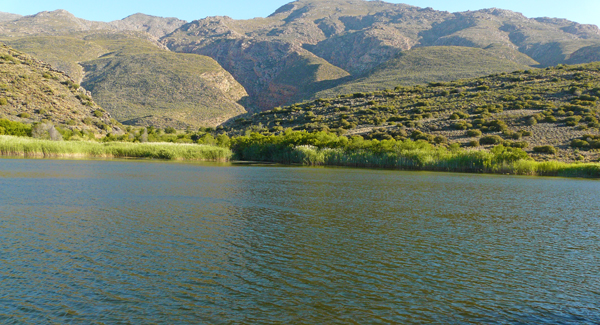
Photo: The (nameless) lake on Hartlands Farm, Vleiland, an ample proof that The Little Karoo should perhaps be called The Green Karoo. (Max Kaizen)
However, the point is that it’s hard to understand why the “Klein Karoo” wasn’t given a more appropriate, not to mention, more flattering name; the Grassy Karoo perhaps, the Green Karoo, or even the Emerald Karoo, given it’s more fertile than the area which henceforth will be known as “The Giga Karoo”.
In his book Ripped My Flesh, travel writer Tim Cahill plays with this notion of naming while walking in a little-travelled region of Peru, I think it was. In a moment, you suspect, of delirious exhaustion following a long walk on the edge of the Andes, Cahill names an old Inca gravesite, of which there are hundreds all over the place, “Tim’s Mound”. He said that many people might think the name lacked a certain mellifluous quality, but he thought it sang.
I had the same experience driving on our farm in the Karoo soon after we bought it. The almost non-existent road dropped into a riverbed at one point, and as I recalled this passage, I thought, you know what, I’m going to call this spot “Tim’s Drif”.
And so “Tim’s Drif” passed through that imaginery veil into the realm of consciousness. Unfortunately, the spot has become notable not so much for its name as for the spot where visitors’ cars get stuck.
The downbeat quality of place names is caused perhaps by being slightly awestruck at the responsibility of naming. My experience of naming encouraged us to give our visitors the task of naming things. This triggered a mad, creative rush of ideas, and now all kinds of things have interesting and imaginative names, each one of which makes me feel progressively more embarrassed about having used up my name on a dip in the road.
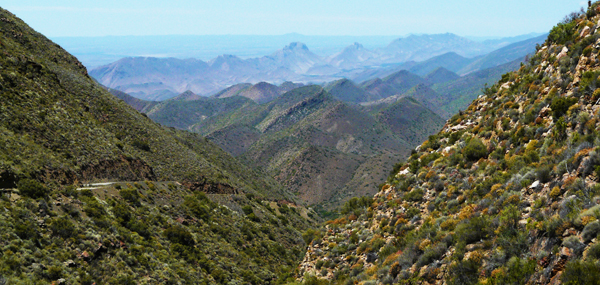
Photo: The lonely road to Gamkapoort Dam. The Great Karoo looms beyond the rugged hills. (Max Kaizen)
Discretion prevents me from naming the namers, but these are some examples. The gorge on the mountain side of our property was given the name “Us” because it is, in fact, gorgeous. The view of the hills through the valley is called the “Karoo Kush”. The ridge across from our house is called “Dragon Ridge”.
The whole naming process has, in fact, got a bit out of hand in its creativity and attempts at clever one-upmanship. A three hills in the distance that are, respectively, rounded, rounded with a dent, and one that looks like a face looking up at the sky are called “Humpback”, “Brokeback” and “Laidback”.
Some other namers have been completely immune to the modestly element and named enormous hills after themselves. “Summer’s Ridge”, for example, was not named for any seasonal quality.
Many guests have given up on the physical landscape entirely. Our stoop sofa has been named “Sofia” in recognition of Sofia Loren’s curvaciousness. Our prized wire-and-glass-bead sheep, bought with the faux intention of keeping up with the local farming community (Do you have sheep? Oh definitely. How many? Er, one actually. What kind? Er … beaded. Bearded? No, beaded.) has actually been named twice: M. Baba Mouton and A, from Philip K. Dick’s Do Androids Dream of Electric Sheep?. Very lateral.
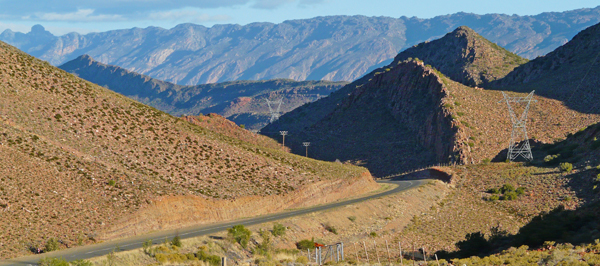
Photo: The road from Ladismith to Laingsburg. (Max Kaizen)
That it’s all fun is in sharp contrast to the somewhat dour practicality with which most of the things have traditionally been classified in our area. The original farm, of which ours is now only a portion, was called Bloemendaal, interestingly still registered with the original Dutch spelling. Next door is Scheepers Rus, and next door to that is Tabaklande.
The stiff practicality of the original namers of the region shows through in the plain and obvious names with which they anointed their new living quarters – what was in the river, what grew, whether the water was fresh, what animals were in the region and who lived where. All of this is seemingly mundane now, but it was perhaps less so back in the day when these things mattered a great deal more.
When emotion became involved, it was usually depressive, as in Vergelegen, literally placed far away, or to put it another way, a really irritatingly long drive from the damn town, or Allesverloren, all is lost, which is odd for a place which was presumably recently found.
When you think about it, the greatest thing about the naming process is not trusting that the names will last, but wondering whether they will. Naming is a matter of taste and convention, but it’s also a matter of power. The fierce debates about city names in South Africa are really a subdued or displaced argument on authority. Those with authority, name. Those subject to that authority, must respect those names.
But here in the Karoo wilderness, the whole process is so much more whimsical and for that reason so much more of a joy. We name, we un-name. Nobody cares really. Least of all us. DM
Main photo: Just about every road in the Karoo hints at an adventure just beyond the corner. (Max Kaizen)
Related: The Karoo Chronicles I: The Moon is a Baboon



















 Become an Insider
Become an Insider